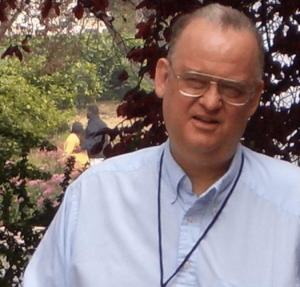Ralph Merkle facts for kids
Quick facts for kids
Ralph Merkle
|
|
|---|---|

Merkle in 2007
|
|
| Born | February 2, 1952 Berkeley, California, US
|
| Education |
|
| Known for |
|
| Spouse(s) | Carol Shaw |
| Awards | IEEE Richard W. Hamming Medal (2010) Computer History Museum Fellow (2011) |
| Scientific career | |
| Fields | Public key cryptography, cryonics |
| Institutions |
|
| Thesis | Secrecy, authentication and public key systems |
| Doctoral advisor | Martin Hellman |
Ralph C. Merkle, born on February 2, 1952, is an American computer scientist and mathematician. He is famous for helping to create public-key cryptography. This is a super important way to send secret messages online. He also invented cryptographic hashing, which helps keep digital information safe. More recently, he has studied and spoken about cryonics. This is the idea of preserving bodies at very low temperatures.
Merkle is a well-known expert in cryptography, the science of secure communication. He came up with "Merkle's Puzzles." He also helped invent the Merkle–Hellman knapsack cryptosystem. He created cryptographic hashing, which is now called the Merkle–Damgård construction. He also invented Merkle trees, which are used to organize and verify data.
He has worked at several important places. These include Elxsi, Xerox PARC, and Zyvex. He was also a professor at Georgia Tech. He has been a faculty member at Singularity University. He is also on the board of the Alcor Life Extension Foundation. In 2010, he received the IEEE Richard W. Hamming Medal. He has written about molecular manipulation and self-replicating machines. Ralph Merkle is related to baseball star Fred Merkle. He is married to video game designer Carol Shaw. He is involved with the cryonics group Alcor Life Extension Foundation. He even appears in the science fiction novel The Diamond Age.
Contents
Ralph Merkle's Big Ideas
While he was still a college student, Ralph Merkle came up with "Merkle's Puzzles." This was a clever way to communicate securely over an unprotected connection. He developed this idea for a class project at UC Berkeley. Today, this method is seen as an early example of public key cryptography. This type of cryptography lets people send secret messages without sharing a secret key beforehand.
How Merkle's Ideas Keep Data Safe
Merkle also helped create the Merkle–Hellman knapsack cryptosystem. This was another early way to encrypt information. He invented cryptographic hashing, which is now known as the Merkle–Damgård construction. This method is used in many hashing algorithms. Hashing turns data into a short, unique code. This code helps check if the data has been changed.
He also invented Merkle trees. These are like digital fingerprints for large amounts of data. They help verify that data is correct and hasn't been tampered with. At Xerox PARC, Merkle designed special codes called Khufu and Khafre block ciphers. He also created the Snefru hash function. These were all tools to make digital communication more secure.
Ralph Merkle's Career Journey
Ralph Merkle has had a long and interesting career. From 1980, he managed the creation of computer programs at Elxsi. In 1988, he became a research scientist at Xerox PARC. This is a famous research center known for many computer innovations.
Working with New Technologies
In 1999, Merkle started working as a theorist for nanotechnology at Zyvex. Nanotechnology involves working with tiny materials, often at the atomic level. In 2003, he became a special professor at Georgia Tech. There, he led the Georgia Tech Information Security Center. This center focuses on keeping computer systems safe.
In 2006, he moved back to the San Francisco Bay Area. He became a senior research fellow at IMM. He also joined the faculty at Singularity University. This university focuses on future technologies. He is also a board member of the Alcor Life Extension Foundation. This organization is involved in cryonics. In 2010, he received the IEEE Richard W. Hamming Medal for his important work. He continues to be active in the fields of molecular manipulation and self-replicating machines. He has also published books on these topics.
Ralph Merkle's Personal Life
Ralph Merkle comes from a family with interesting members. His granduncle was the famous baseball player Fred Merkle. His father, Theodore Charles Merkle, was the director of Project Pluto. This was a special project involving nuclear-powered engines. His sister, Judith Merkle Riley, was a writer of historical novels.
Ralph Merkle is married to Carol Shaw. She is a well-known video game designer. She is best known for creating the 1982 Atari 2600 game River Raid. Merkle is also on the board of directors for the cryonics organization Alcor Life Extension Foundation. He is even featured in the science fiction novel The Diamond Age. This book explores ideas about nanotechnology.
Awards and Recognition
Ralph Merkle has received many awards for his groundbreaking work.
- 1996: Paris Kanellakis Award from the ACM. This was for his invention of Public Key Cryptography.
- 1998: Feynman Prize in Nanotechnology. He won this for his computer models of tiny tools. These tools could perform very precise chemical reactions.
- 1999: IEEE Koji Kobayashi Computers and Communications Award.
- 2000: RSA Award for Excellence in Mathematics. This was also for his invention of public key cryptography.
- 2008: Became a fellow of the International Association for Cryptographic Research (IACR). This was for his work on public key cryptography.
- 2010: IEEE Richard W. Hamming Medal. This award recognized his invention of public key cryptography.
- 2011: Became a Computer History Museum Fellow. This honor was for his work on public key cryptography with Whitfield Diffie and Martin Hellman.
- 2011: Inducted into the National Inventors Hall of Fame. This was for his invention of public key cryptography.
- 2012: Inducted into the National Cyber Security Hall of Fame.
- 2020: Received the Levchin Prize. This was for his key contributions to public key cryptography, hash algorithms, Merkle trees, and digital signatures.

